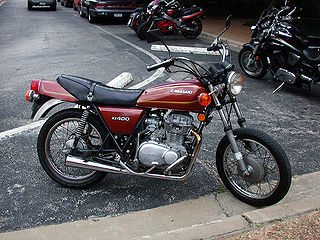
Kawasaki kz400
Encyclopedia

Motorcycle
A motorcycle is a single-track, two-wheeled motor vehicle. Motorcycles vary considerably depending on the task for which they are designed, such as long distance travel, navigating congested urban traffic, cruising, sport and racing, or off-road conditions.Motorcycles are one of the most...
produced by Kawasaki between 1974 and 1984. It was developed into a larger brother, the Z/KZ440 where the stroke was lengthened to increase engine capacity.
Twins
The "original" Kawasaki KZ400 was a 398 cc twin cylinder motorcycle produced from 1974 to 1984, though some later models displaced 440 cc. The KZ400 was built at plants in AkashiAkashi
-People:*Akashi Ken*Akashi Momoka*Akashi Morishige*Akashi Motojiro*Akashi Shiganosuke*Akashi Yasushi-Places:*Akashi, Hyōgo*Akashi Station - Japanese railroad station on the Sanyō Main Line*Akashi-Kaikyō Bridge*Akashi Castle*Akashi Domain-Other:...
, Japan and Lincoln, Nebraska
Lincoln, Nebraska
The City of Lincoln is the capital and the second-most populous city of the US state of Nebraska. Lincoln is also the county seat of Lancaster County and the home of the University of Nebraska. Lincoln's 2010 Census population was 258,379....
. The Lincoln plant (built in 1974) made Kawasaki the first foreign motorcycle manufacturer to operate a plant in the United States. The KZ400 outsold Honda
Honda
is a Japanese public multinational corporation primarily known as a manufacturer of automobiles and motorcycles.Honda has been the world's largest motorcycle manufacturer since 1959, as well as the world's largest manufacturer of internal combustion engines measured by volume, producing more than...
in the 400 cc twins market through the 1970s. These motorcycles were marketed as fuel efficient transportation; a 1975 magazine advertisement for Kawasaki featured the KZ400 next to a Volkswagen Beetle
Volkswagen Beetle
The Volkswagen Type 1, widely known as the Volkswagen Beetle or Volkswagen Bug, is an economy car produced by the German auto maker Volkswagen from 1938 until 2003...
with the tag line "Think even smaller."
Early models were prone to oil leaks and unstable idling. Both the carburetors and the design of the oil passages were redesigned beginning in 1977. Some models were offered as bare-bones transportation, with no electric start and front drum brakes. Most, however, had a single disc in the front and drum in the rear as well as electric and kick starters. Deluxe models also had a fairing and saddle bags.
Fours
The Kawasaki KZ400 had an inline four cylinder variant named the Kawasaki KZ400-J, which had a slightly different engine derived from the larger Kawasaki Z500/Z550Kawasaki Z500/Z550
The Kawasaki Z500/Z550 series began with the 1979 Z500, a scaled-down version of the Kawasaki Z1R. It used a double-cradle steel frame with a transverse-mounted air-cooled 4-cylinder DOHC engine--a classic universal Japanese motorcycle.-Z500/Z550 :This was the first of the line, with a 500cc...
models. The KZ400J was produced from 1980-1983, and was available in a "West Germany" version limited to 25 kW. The engine was an air-cooled four-cylinder, four-stroke, eight-valve DOHC engine, accompanied by a six-speed gearbox. These bikes were electric start only, and the KZ400-J had a single (US model) or double (UK, Western Germany models) disc brake at the front, and a drum brake rear.
The 1980 model was identified as Kawasaki KZ400-J1, while in 1981 the Kawasaki KZ400-J2 was introduced with small differences, like a transistorised ignition system.
Engine datasheet
| KZ400-J | |
|---|---|
| Bore and Stroke | 64.0 x 62.0 mm |
| Displacement | 399 cc |
| Compression ratio | 9.5 |
| Engine oil | 3.0L of SE class SAE 10W40, 10W50, 20W40 or 20W50 |
| Cyl. numbering | LTR 1-2-3-4 |
| Ignition pattern | 1-2-4-3 |
| Spark plugs | NGK D8EA or ND X24ES-U |
Transmission data
| KZ400-J | |
|---|---|
| 1st gear | 2.57 (36/14) |
| 2nd gear | 1.78 (32/18) |
| 3rd gear | 1.38 (29/21) |
| 4th gear | 1.13 (27/24) |
| 5th gear | 0.96 (25/26) |
| 6th gear | 0.85 (23/27) |
| Primary red. ratio | 3.28 (27/23*67/24) |
| Final red. ratio | 2.50 (40/16) |
| Overall drive ratio | 6.98 (Top Gear) |

